Algae as vessels for synthetic biology
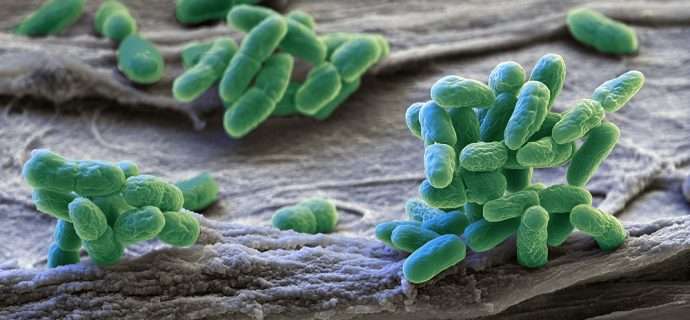
Algae (a term used to group many photosynthetic organisms into a rather heterologous mash-up) do not have a kind place in the public imagination. Take for example the following passage from Stephen King's Pet Semetary:
"Dead fields under a November sky, scattered rose petals brown and turning up at the edges, empty pools scummed with algae, rot, decomposition, dust… "
Leaving aside their use in a horror novel as a way to set an image of decay, algae attract significant scientific attention, and are even considered cool (well, at least by some). But when I tell people I work on algal Synbio, one question that eventually comes up (or is silently implied) is why do I bother, when there are more prominent and better-developed systems? In this blog I will try to partly address this point of view, as well as provide a small perspective on the subject.
The practical benefits of algae for humans date back to the days of early photosynthesis, when they produced the oxygenic atmosphere we currently breathe. Moreover, algal forms were the ancestors of chloroplasts and land plants. Today, algae are found in almost every environment, in having various forms and ecological roles. But what is their place in synthetic biology?
In terms of algal synthetic biology and biotechnology, there are two main research domains: eukaryotic microalgae and cyanobacteria.
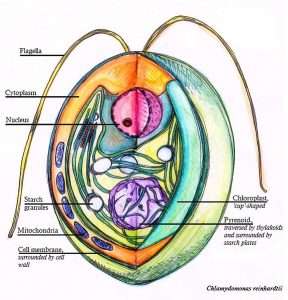
The model for studying eukaryotic microalgae is Chlamydomonas reinhardtii—although the use of more species is being explored. C. reinhardtii can be transformed both via nuclear and chloroplast transformation, each having different potentials (e.g. random insertion vs. homologous recombination, eukaryotic vs. prokaryotic translation and protein maturation, etc.)
So far a few pharmaceutical proteins have been produced in eukaryotic algae, such as antibodies, immunotoxins, and vaccines against malaria and influenza. Additionally Chlamydomonas was the first photosynthetic organism where continuous bio-hydrogen production was observed, while there are many algae that overproduce lipids and carotenoids.
However, cyanobacteria are my personal favorite organisms. They receive increased attention as Synbio hosts, and they have been used for the heterologous production of many compounds. Their attractiveness can be explained by the fact that they are prokaryotic organisms, and they have the ability to perform oxygenic photosynthesis. This means that they are a Synbio platform where bacteria and plants can meet, where characterized parts from both photosynthetic organisms and well-studied prokaryotes can be utilized.
Algae and cyanobacteria have the potential to provide sustainable biotechnological solutions. They do not need arable land and they do not use sugars as carbon sources, thus they do not compete with resources that could be otherwise utilized for food production or conservation. This is in stark contrast with the current use of crop plants or heterotrophic bacteria for bioethanol production, as well as other potential plant applications (see discussion by Georgianna and Mayfield, 2012).
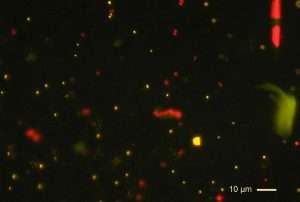
They fix CO2, and some species even nitrogen. The importance of carbon fixation is obvious under the light of climate change and increasing greenhouse-gas emission, while soil depletion of inorganic nutrients is a viable threat to agriculture and the environment in general. Moreover, algae bring to the table photosynthesis, readily available redox potential to drive complex metabolic reactions, and a lot of membrane space—membranes define cellular compartments, and membrane interactions are crucial for the function of many biosynthetic enzymes.
The cyanobacterial carbon concentrating organelle (carboxysome) has been proposed as a means to enhance crop plant photosynthesis or act as protein-domains assembly platforms. In a very cool approach, Kerfeld and coworkers used the simple principle that many protein functions are due to different domain fusions that happened during evolution. As a result, they constructed chimeric carboxysome core proteins that fuses different domains, can assemble fully functional carboxysomes, and can be used as a platform to deliver catalytic domains and novel functions into this micro-compartment.
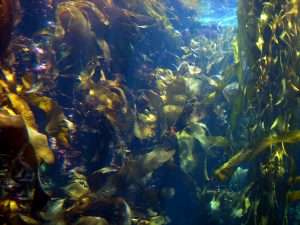
However, algal synthetic biology is lagging behind more "traditional" sub-disciplines. One reason is the shortage of a developed genetic engineering toolbox. Some eukaryotic algae are a nightmare to transform, and even the most easy-to-work with cyanobacteria, lack well-studied parts and techniques for high-throughput analysis. The picture is changing though, with the characterization of cyanobacterial genetic elements, transposon libraries, new tools for eukaryotic algae, and CRISPR (developed for cyanobacteria, Chlamydomonas, and diatoms).
In addition, algal biotechnology has not yet delivered a commercial success story, other than the use of Arthrospira (spirulina) as a food supplement. A few early attempts to produce biofuels have not come into fruition (e.g. see some unsuccessful biofuel enterprises and Sapphire's change of market focus), while metabolic engineering approaches have not achieved the titers delivered by heterotrophic hosts. Algae grow slower than bacteria and budding yeast, they cannot reach very high cell densities—as they shade each other and limit light penetration to the culture—and behave differently in laboratory and outdoor cultivation conditions.
Nevertheless, algae are not to be easily dismissed. More and more sophisticated research appears in the literature, and the industry is taking the lead, as the rising number of algae companies implies. In reality, we might not be very far from algae-powered photosynthetic houses or algae-made commercial products. We—humans—need environmental-friendly applications and solutions, and I think that algae is definitely a way to make our road towards the future greener.
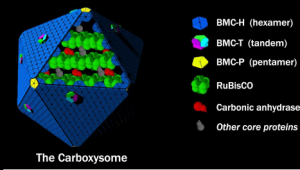
Provided by Public Library of Science
This story is republished courtesy of PLOS Blogs: blogs.plos.org.



















